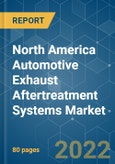The North America Automotive Exhaust Aftertreatment Systems Market is expected to register a CAGR greater than 8.7% during the forecast period (2020 - 2025).
The technological level for the Automotive Exhaust Aftertreatment Systems Market has evolved with modern engine design and active exhaust gas aftertreatment systems. As a result, there is a decrease in exhaust emissions from automobiles over the past few years. Although, with continuous production in vehicle numbers and with car ownership reaching its all-time high, there are tremendous challenges for scientists and engineers to develop improved exhaust aftertreatment systems. In the future
North America region is one of the largest markets for Automotive Exhaust Aftertreatment Systems. All this is due to stringent regulations imposed by the government. The United States Department of Energy (DOE) has partnered with domestic OEM companies to develop advanced technologies. However, one major drawback is the inability of current catalyst and aftertreatment technologies to provide much lower exhaust temperatures that will accompany highly efficient combustion.
With the emergence of electric vehicles and an increasing ban on diesel vehicles, the market will face challenges, especially in the developed nation, and the growth for Exhaust Aftertreatment Systems will face challenges.
Key Market Trends
Diesel Particulate Filters (DPFs) is the Fastest Growing Technology by Filter Type
Diesel particulate filters (DPFs) are proven technologies to meet light-duty PM control needs. Exhaust Aftertreatment Systems engineers work hand in hand with OEM manufacturers to develop emissions control systems that enable both gasoline and diesel-powered engines to provide cost-effective solutions while also mandating emissions level regulation set by the government.
Compared to gasoline, diesel engines have much higher efficiency and durability to operate with its low operating cost. However, diesel engines are also one of the most significant contributors to harmful exhaust emissions causing environmental pollution. In 2018, diesel's market share fell from 44.0% to 35.9%, while the petrol market share grew from 50.3% to 56.7% since 2017. With technologies such as Particulate control, compound control, NOX control system, and newer exhaust system that features an air gap pipe, it is designed to work together with other components, provide superior thermal efficiency and improve fuel economy.
The Diesel Particulate Filter (DPF) provides an effective solution in which an advanced modular design allows easy cleaning and engine vehicle are servicing every 200,000 miles. Technologies such as the ash modeling particulate Computer-Aided Engineering and computational fluid dynamics help design a better DPF system. Also, such an advanced design allows technicians to remove the DPF from any vehicle in less than 15 minutes.
The United States is Imposing Stringent Emission Regulations on Diesel Automakers
Driven by growing concerns on deteriorating air quality, various government policies have been implemented to reduce the effects of diesel engine emissions on human health and the environment. Across the globe, drastic measures are being taken to adopt and enforce tighter vehicular emission regulations. The main aim is to minimize unburned hydrocarbons, nitrogen oxides (NOx), and particulate matter (PM).
In the US, vehicles sold by the manufacturers must meet Tier 2 Bin 5 level emissions targets; thus, the sale of cars with emissions higher than Bin 5 levels must be offset by the sale of vehicles with correspondingly lower emissions levels than Bin 5.
Performance targets for low-temperature aftertreatment modeling R&D include Catalyzed NOx reduction, Catalytic HC, NO, and CO oxidation, Passive storage of NOx, HC, and CO, Soot filter regeneration, Fuel effects on the above (e.g., alternative and renewable fuels) and Integrated catalyst architectures (e.g., layered or segmented catalysts).
USA and Canada have advanced regulations which focus on limiting the pollutant. With improved technology and awareness, the intensity to limit global warming and reduce fossil fuel use in the transportation sectors on the rise. Several North American nations have pledged to carbon dioxide emissions and impose Carbon tax criteria for greenhouse gases and pollutants emission automotive carmakers. All the above is leading to the rapid adoption of advanced aftertreatment technologies.
Competitive Landscape
The North America Automotive Exhaust Aftertreatment market is consolidated with existing market players such as Delphi Technologies PLC, Cummins, and Tenneco, which hold the most significant shares. To have the edge over its competitors' companies are making joint-ventures, partnerships, launching new products with advanced technology.
For instance, in 2019, Faurecia completed the acquisition of Clarion. The company, along with Clarion with previous purchases of Parrot Automotive and Coagent Electronics, to form the Clarion Electronics Business Group.
Additional Benefits:
- The market estimate (ME) sheet in Excel format
- 3 months of analyst support
This product will be delivered within 2 business days.
Table of Contents
Methodology

LOADING...








